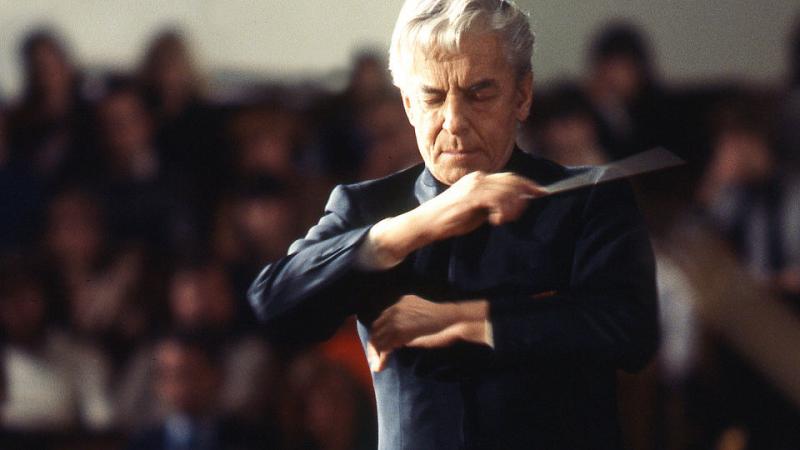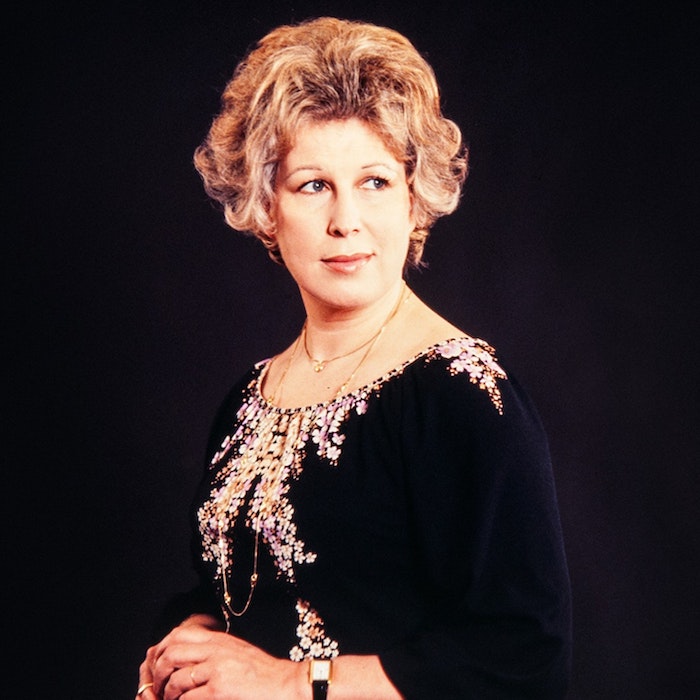Berlin Philharmoniker, Karajan, Digital Concert Hall review - a captivating musical time capsule | reviews, news & interviews
Berlin Philharmoniker, Karajan, Digital Concert Hall review - a captivating musical time capsule
Berlin Philharmoniker, Karajan, Digital Concert Hall review - a captivating musical time capsule
Online archive captures a conducting titan in Brahms's 'Ein Deutsches Requiem'

When I saw that the Berlin Philharmonic had thrown open the doors to its virtual concert hall the thing that most interested me was to see some Karajan. When I was a child in the mid-1980s I lived for a while in Berlin and my father took me to the Philharmonie several times. I remember seeing Karajan, then in the final years of his long Berlin reign.
Although by the mid-1980s Karajan was physically diminished, in the filmed concert I have chosen to focus on in 1978 he was in his pomp. As a conductor his central concern was the mainstream of the German classical tradition, so I thought I would watch the Berlin Philharmonic accompany the Vienna Singverein, who he also worked with over many years, in Brahms’s Ein Deutsches Requiem.
It took me a while, so unaccustomed have I become to watching concerts on the screen, to get used to the visual language. The filming is subtle and much less busy than later filming techniques. There is a limited number of cameras – perhaps seven or eight – and their shots are mostly stationary, without any sweeping or panning. Long crossfades take us from one image to another, but the director is happy to stay on a single shot for a long time, especially if it features Karajan himself, who is silver-haired and statuesque. Conducting the 70-minute Requiem without music and often with his trademark closed eyes, Karajan is utterly captivating to watch.
 The choir are spaced roughly two metres from each other in diagonal stagger, which on the one hand looks strange, but at the same time captures the social distancing of today rather aptly. Like Karajan performing from memory, the choir are robed in purple and peopled by a fair share of redoubtable Austrian Frauen, and the sound can sometimes be a bit matronly, but the men of the choir are meaty and echt. The choir does achieve a wonderful range of dynamics, from the whispered first entry to the several massive climaxes but inevitably these are flattened out on the soundtrack and there isn’t the impact of a live performance.
The choir are spaced roughly two metres from each other in diagonal stagger, which on the one hand looks strange, but at the same time captures the social distancing of today rather aptly. Like Karajan performing from memory, the choir are robed in purple and peopled by a fair share of redoubtable Austrian Frauen, and the sound can sometimes be a bit matronly, but the men of the choir are meaty and echt. The choir does achieve a wonderful range of dynamics, from the whispered first entry to the several massive climaxes but inevitably these are flattened out on the soundtrack and there isn’t the impact of a live performance.
The performance as a whole certainly romanticises Brahms’s sometimes bleak vision, with a viscous string sound and flawless ensemble (that is, within the orchestra: occasionally the choir is slightly dislocated). The smoothing of the edges works best in the consolatory movements, such as the choral fourth and the soprano solo of the fifth, sung here by an extraordinary Gundula Janowitz (pictured above by Jürgen Kranich), whose voice is powerful but with a very restrained vibrato. Her baritone counterpart José van Dam has a disconcerting likeness to 70s-era John Cleese but is focused and direct.
There are thrills in the climaxes: some terrific timpani playing amid the drama of the second movement, a spine-tingling fugue at the end of the sixth movement with its climax of heroic climbing trombones. But it is perhaps the shaping of the whole where Karajan excels, keeping the entire piece in his head all the time. And this mastery is repaid by the adoration clear in the television direction, with its unashamed elevation of the conductor to hero status.
It’s a treat to watch, a glimpse into past concert-giving and screen presentation, which I am glad to have had the opportunity to discover, and put alongside my own memories of a frail old man bringing his orchestra to life with a twitch of his hand.
- Watch the concert film (free subscription)
- From tomorrow (Good Friday) for 48 hours, Paavo Järvi's performance of the Deutsches Requiem with the Deutsche Kammerphilhamonie from Bremen Cathedral on the orchestra's website
- Read more classical reviews on theartsdesk
rating
Share this article
Add comment
The future of Arts Journalism
You can stop theartsdesk.com closing!
We urgently need financing to survive. Our fundraising drive has thus far raised £49,000 but we need to reach £100,000 or we will be forced to close. Please contribute here: https://gofund.me/c3f6033d
And if you can forward this information to anyone who might assist, we’d be grateful.

Subscribe to theartsdesk.com
Thank you for continuing to read our work on theartsdesk.com. For unlimited access to every article in its entirety, including our archive of more than 15,000 pieces, we're asking for £5 per month or £40 per year. We feel it's a very good deal, and hope you do too.
To take a subscription now simply click here.
And if you're looking for that extra gift for a friend or family member, why not treat them to a theartsdesk.com gift subscription?
more Classical music
 Anja Mittermüller, Richard Fu, Wigmore Hall review - a glorious hall debut
The Austrian mezzo shines - at the age of 22
Anja Mittermüller, Richard Fu, Wigmore Hall review - a glorious hall debut
The Austrian mezzo shines - at the age of 22
 First Person: clarinettist Oliver Pashley on the new horizons of The Hermes Experiment's latest album
Compositions by members of this unusual quartet feature for the first time
First Person: clarinettist Oliver Pashley on the new horizons of The Hermes Experiment's latest album
Compositions by members of this unusual quartet feature for the first time
 Gesualdo Passione, Les Arts Florissants, Amala Dior Company, Barbican review - inspired collaboration excavates the music's humanity
At times it was like watching an anarchic religious procession
Gesualdo Passione, Les Arts Florissants, Amala Dior Company, Barbican review - inspired collaboration excavates the music's humanity
At times it was like watching an anarchic religious procession
 Classical CDs: Camels, concrete and cabaret
An influential American composer's 90th birthday box, plus British piano concertos and a father-and-son duo
Classical CDs: Camels, concrete and cabaret
An influential American composer's 90th birthday box, plus British piano concertos and a father-and-son duo
 Cockerham, Manchester Camerata, Sheen, Martin Harris Centre, Manchester review - re-enacting the dawn of modernism
Two UK premieres added to three miniatures from a seminal event of January 1914
Cockerham, Manchester Camerata, Sheen, Martin Harris Centre, Manchester review - re-enacting the dawn of modernism
Two UK premieres added to three miniatures from a seminal event of January 1914
 Kempf, Brno Philharmonic, Davies, Bridgewater Hall, Manchester review - European tradition meets American jazz
Bouncing Czechs enjoy their Gershwin and Brubeck alongside Janáček and Dvořák
Kempf, Brno Philharmonic, Davies, Bridgewater Hall, Manchester review - European tradition meets American jazz
Bouncing Czechs enjoy their Gershwin and Brubeck alongside Janáček and Dvořák
 Solomon, OAE, Butt, QEH review - daft Biblical whitewashing with great choruses
Even a top soprano and mezzo can’t make this Handel paean wholly convincing
Solomon, OAE, Butt, QEH review - daft Biblical whitewashing with great choruses
Even a top soprano and mezzo can’t make this Handel paean wholly convincing
 Two-Piano Gala, Kings Place review - shining constellations
London Piano Festival curators and illustrious friends entertain and enlighten
Two-Piano Gala, Kings Place review - shining constellations
London Piano Festival curators and illustrious friends entertain and enlighten
 Echo Vocal Ensemble, Latto, Union Chapel review - eclectic choral programme garlanded with dance
Beautiful singing at the heart of an imaginative and stylistically varied concert
Echo Vocal Ensemble, Latto, Union Chapel review - eclectic choral programme garlanded with dance
Beautiful singing at the heart of an imaginative and stylistically varied concert
 Scott, Irish Baroque Orchestra, Whelan, RIAM, Dublin review - towards a Mozart masterpiece
Characteristic joy and enlightenment from this team, but a valveless horn brings problems
Scott, Irish Baroque Orchestra, Whelan, RIAM, Dublin review - towards a Mozart masterpiece
Characteristic joy and enlightenment from this team, but a valveless horn brings problems
 Classical CDs: Voice flutes, flugelhorns and froth
Baroque sonatas, English orchestral music and an emotionally-charged vocal recital
Classical CDs: Voice flutes, flugelhorns and froth
Baroque sonatas, English orchestral music and an emotionally-charged vocal recital

Comments
Thank you so much for posting